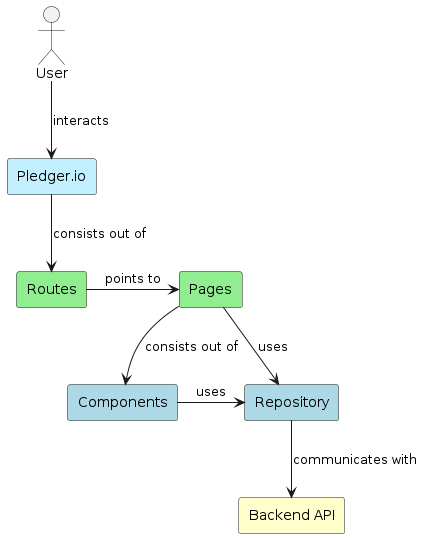The UI design for Pledger.io
The user interface is a React-based application. It is built up using the following frameworks and tools:
-
React, used as the UI framework.
-
Typescript, used as the programming language.
-
Chart.js, used for the rendering of the various charts inside the application.
-
Primereact, used as the primary UI component library for the application.
-
axios, used for the communication with the REST-api.
Overview
The Pledger.io application follows a layered architecture pattern, separating concerns into distinct layers that interact with each other in a controlled manner. This document describes the high-level architecture of the application, including its main layers and components.
Architecture Diagram
The following diagram illustrates the high-level architecture of the Pledger.io application:

As can be seen, there is one main entry point the user interacts with, the Pledger.io component.
Each page is represented in a route, but multiple routes can lead to the same page.
Every page can consist out of multiple components.
The components and pages can use the repository layer to access the backend application.
Architectural Layers
Entry Points
-
index.jsx: The main entry point of the application that bootstraps the React application.
-
pledger-io.tsx: The main application component that sets up the application context and routing.
Pages
Pages are React components that represent full screens in the application. They include:
-
Dashboard Page: The main landing page showing an overview of the user’s financial status.
-
Login/Register Pages: Authentication pages for user login and registration.
-
Account Pages: Pages for managing financial accounts.
-
Budget Pages: Pages for creating and managing budgets.
-
Transaction Pages: Pages for viewing, creating, and managing transactions.
-
Contract Pages: Pages for managing recurring financial contracts.
-
Report Pages: Pages for generating and viewing financial reports.
-
Automation Pages: Pages for setting up and managing automation rules.
-
Settings Pages: Pages for configuring application settings.
Components
Components are reusable UI elements that are used across multiple pages. They include:
-
Layout Components: Components for page layout, such as headers, footers, and navigation.
-
Form Components: Reusable form elements and validation.
-
Account Components: Components specific to account management.
-
Budget Components: Components for budget visualization and management.
-
Transaction Components: Components for transaction listing, filtering, and editing.
-
Contract Components: Components for contract management.
-
Report Components: Components for report generation and visualization.
-
Upload Components: Components for file uploading.
-
Dashboard Components: Components for the dashboard, such as summary cards and charts.
Repositories
Repositories provide a clean abstraction for data access, following the Repository pattern. They include:
-
Account Repository: Handles operations related to financial accounts.
-
Budget Repository: Handles operations related to budgets.
-
Category Repository: Handles operations related to transaction categories.
-
Contract Repository: Handles operations related to financial contracts.
-
Rule Repository: Handles operations related to automation rules.
-
Security Repository: Handles operations related to authentication and authorization.
-
Profile Repository: Handles operations related to user profiles.
-
Statistical Repository: Handles operations related to financial statistics and reports.
-
Savings Repository: Handles operations related to savings goals.
-
Process Repository: Handles operations related to background processes.
-
Import Job Repository: Handles operations related to importing financial data.
